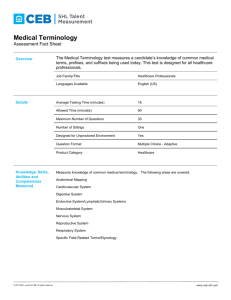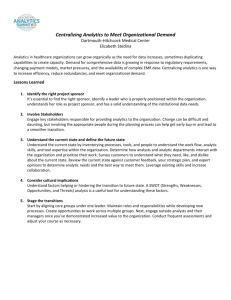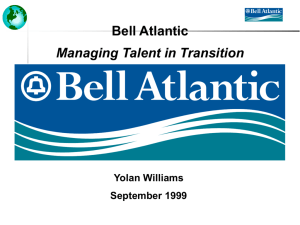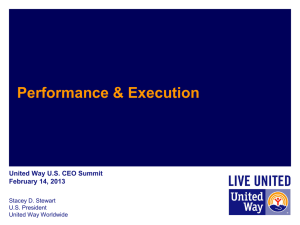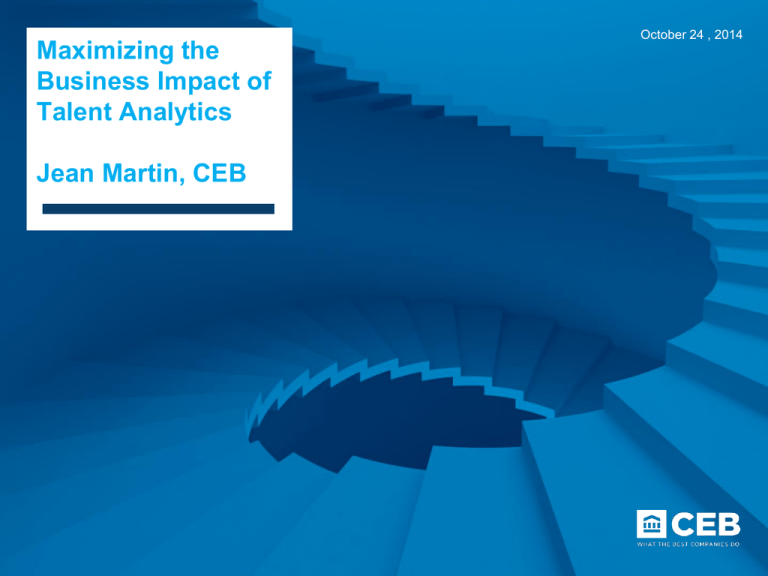
Maximizing the
Business Impact of
Talent Analytics
October 24 , 2014
Jean Martin, CEB
© 2014 SHL, a part of CEB. All rights reserved
1
Pressure on HR to capitalize on data assets
CEOs Want More Talent Data from HR
Percentage of CEOs Who Believe Information
Is Important and Comprehensive
HR Plans to Increase Investments in HR
Data and Analytics in the Next Two Years
Percentage of Senior HR Leaders
Costs of
Employee
Turnover
95%
Return on
Investment in
Human Capital
Agree
Assessments of
Internal
Advancement
n = 108.
Labor
Costs
Source: CEB, CEB Corporate Leadership Council Analytics Survey 2013.
Employees’
Views and
Needs
Information Is
Important
Receives
Sufficient
Information
Staff
Productivity
0%
50%
100%
Percentage of CEOs
n = 1,258.
Source: PwC, “15th Annual Global CEO Survey,” 2012, http:/ /www.pwc.com/en_GX/gx/ceo-survey/pdf/15th-global-ceo-survey.pdf.
© 2014 SHL, a part of CEB. All rights reserved
2
Data is not leading to insights or impact
HR Analytics Has Led Me to Change
a Business Decision in the Past Year
I Believe I am Getting Significant
Returns on Analytics Investments
Percentage of Senior Business Leaders
Percentage of Senior HR Leaders
15%
8%
Agree
Agree
n = 1,590.
Source: CEB, Business Barometer, 2013.
n = 108.
Source: CEB, CEB Corporate Leadership Council Analytics Survey, 2013.
Lots of Data; Minimal Insight
“There’s a lot of data out there but not a lot of information.” VP, HR Mining Company
© 2014 SHL, a part of CEB. All rights reserved
3
From reporting to analytics
From HR using:
Data to provide talent reports
To HR using:
Analytics to improve business decisions
Purpose of reports is to provide
talent information
Purpose of analytics is to
improve business decisions
Information provided is driven by
leader requests and data availability
Analysis and insights link explicitly to
evolving business challenges
Reports provide leaders with
talent metrics
Insights provide implications for
business outcomes
Defining Terms:
Talent Analytics: The discovery and communication of meaningful patterns in talent data
Talent Metrics: Units of measurement for talent data
Talent Dashboards and Reports: Tools to communicate talent data
© 2014 SHL, a part of CEB. All rights reserved
4
New Work Environment amplifies analytics need
Trends Shaping the Future of HR and Their Implications
Trend
Talent Shortage
and Skills
Scarcity
Implications for the HR Function
Degree of
Change
Required in HR
Need for
Talent
Analytics
Succession Planning Deeper into the Organization
Intelligent Sourcing and Attraction
Personalization of EVPs
The New
(Networked)
Work
Environment
Virtual Relationships and Fragmented Work Arrangements
Globalized and
Multigenerational
Workforce
Multi-Generational Management
Network Performance and Learning
Shift from Expat to Local Talent Investments
Knowledge Transfer from Retiring Workers
Convergence
of Talent
Management
and Business
Management
Heightened Talent Scrutiny by Board/CEO
Migration of HR Transaction Processing to Multifunction
Shared Services
© 2014 SHL, a part of CEB. All rights reserved
5
Recent analytics-related questions we are hearing
How do I get more
performance? What
tools and practices
are effective?
What actions can be
taken to increase
HIPO retention?
What are the barriers
to staff mobility
across our
organization?
© 2014 SHL, a part of CEB. All rights reserved
What types of
training are most
effective in
increasing
collaboration?
Which candidate
should I hire?
Who are our most
productive
employees, and how
do we compare to
other companies?
How does pay for
similar jobs and
roles vary across our
organization?
How can we better
hire talent with critical
skills in location “X”?
How are
requirements of
critical jobs and roles
changing in our
industry?
6
Relying on gut instinct
Less Than One-Quarter of Business Leaders Use Data from HR for Key Talent Decisions
Percentage of Business Leaders Who Use HR Data for Key Talent Decisions
100%
25%
24%
24%
24%
24%
23%
23%
23%
22%
22%
Sourcing Talent
Improving Employee
Performance
Improving Employee
Engagement
Selecting HIPOs
Workforce Planning
Creating an EVP
Developing Leaders
Workforce Mobility
Succession Planning
Organizational Design
50%
0%
n = 9,528.
Source: CEB, Global Labor Market Survey, 2013.
Fewer Analytic Tools Exist for Talent Decisions Than Other Critical Business Decisions
“When we make our finance decisions, we use data and spreadsheets. When we make decisions
about our most important asset, our people, we don’t have the same tools.” SVP, Manufacturing
Company
© 2014 SHL, a part of CEB. All rights reserved
7
Technology and analytic sophistication is heralded
as path to success
Sample Talent Analytics Maturity Models
Sample HR Technology Vendors
Source: http:/ /www.bersin.com/lexicon/Details.aspx?id=15302; http:/ /bitools.org/gartnerbi-emea-2013-part-1-analytics-moves-to-the-core/; http:/ /www.deloitte.com/view/en_US/us/
Services/consulting/human-capital/hr-transformation/hrtimes/5b96651f98696310VgnVCM3000001c56f00aRCRD.htm.
© 2014 SHL, a part of CEB. All rights reserved
8
Analytic sophistication alone is insufficient
Improvement in Talent Outcomes By Analytic Sophistication
…further investments in
sophistication alone yield
low additional benefits.
Although a basic level of
analytic sophistication is
necessary for impact…
High
Talent
Outcomes
Include:
Quality of hire
Organizational
Average
Talent Outcomes
Employee
performance
Employee
engagement
Employee
retention
Leadership
bench strength
Low
Low
n = 108.
High
Analytic Sophistication
Foundational Analytic Sophistication Requirements to Achieve Impact
Maintaining consistent data governance and standards
Protecting data from risks to security and confidentiality
Maintaining accessible systems to store data
Source: CEB, CEB Corporate Leadership Council Analytics Survey, 2013.
© 2014 SHL, a part of CEB. All rights reserved
9
A global study
© 2014 SHL, a part of CEB. All rights reserved
10
Analytic impact leads to …
Analytic Impact:
The extent to which talent analytics improves decisions and provides actionable support
to key stakeholders
Decision Improvement:
Actionable Support:
“Analytics Support from the
HR Function Improves
Talent Decisions”
“HR Is Effective at Providing Actionable
Data-Based Guidance on Key Talent Areas”
Improvement of decisions
made by:
CEO
Board of Directors
Business Leaders
Line Managers
■
■
■
■
+
Key talent areas include:
Sourcing
Performance Evaluation
HIPO Selection
Leadership Development
Employee Engagement
Succession Planning
Compensation and Benefits
■
■
■
■
■
■
■
© 2014 SHL, a part of CEB. All rights reserved
11
… talent and business outcomes
Analytic Impact Improves Key Talent Outcomes
Difference in Analytic Impact Between Leading Analytic Organizations and the Average Organization
Average Improvement in Key Talent Outcomes by Leading Analytic Organizations = 12%
1.00
1.17
Bench Strength
1.00
1.12
Employee
Performance
Average
Organization
1.00
1.10
Quality of Hire
Leading Analytic
Organizations
(top quartile)
1.00
1.09
Employee
Engagement
Analytic Impact =
Decision Improvement +
Actionable Support
n = 108. Source: CEB, CEB Corporate Leadership Council, Analytics Survey 2013.
1. Financial information on participating organizations was collected through Compustat for organizations where it was available. The median organization has $9.21 billion in revenue
and a 30.76% gross profit margin. Increasing from median to maximum Analytic Impact improves collected talent outcomes by 12 percentage points, which in turn leads to a 6%
increase in gross profit margin.
2. Talent outcomes were identified by senior HR leaders and surveyed organizations and validated through other internal CEB surveys.
© 2014 SHL, a part of CEB. All rights reserved
12
The business application gap
Analytic Impact and Effectiveness at Business Application and Sophistication
Business Application1
High
High Application,
Low Sophistication
Leading Analytic
Organizations
Average Analytic Impact:
1.14x
3% of organizations
Average Analytic
Impact: 1.22x
17% of organizations
Only 17% of
organizations match
high sophistication
with business
application of insights.
Best Path to Impact
Low Application,
Low Sophistication
Low Application,
High Sophistication
Average Analytic
Impact: 1.00x
60% of organizations
Average Analytic
Impact: 1.05x
20% of organizations
Low
Low
2
Sophistication
High
1 Business Application is measured by
effectiveness at identifying the right
business problems, applying business
judgment to data, and engaging leaders
to take action.
2 Sophistication is measured by
effectiveness at complex analyses (e.g.,
higher order data modeling,
sophisticated systems).
Source: CEB, CEB Corporate Leadership Council Analytics Survey, 2013.
© 2014 SHL, a part of CEB. All rights reserved
13
CEB tested more than 200 metrics
The Long Tail of Metrics
Percentage of Organizations Reporting Usage by Metric
These metrics covered
a wide variety of talent
areas, including:
Percentage of Organizations
Reporting the Metric
100%
CEB asked members which metrics they
track across their organization and report
to the Board of Directors or the CEO.
Employee
engagement
Learning and
development
Performance
management
50%
Recruiting
Succession
planning
Workforce planning
0%
Metrics
Source: CEB, CEB Corporate Leadership Council Analytics Survey, 2013.
© 2014 SHL, a part of CEB. All rights reserved
14
No shortage of metrics
Wide Range of Metrics from “Mild” to “Wild”
Mild
Average Employee Compensation
# FTEs
Benefits Expense as Percentage of Revenue
Cost/FTEs
Absentee Rate
Total Compensation Per Employee
Compensation Expense Per FTE
Employee Commitment Index
Benefits Cost Per Employee
Benefits Expense as Percentage of Total Operating Expense
Internal Pay Equity
Employment Brand Strength
Employee Engagement Level
Employee Retention Index
Cost Per Hire
Revenue per Employee
Forecast the future organizational structure based
on current hiring and promotion practices.
Hire and Promotion Rate (Google)
Departure Probability (Sprint)
Employee Loyalty Statistic (JetBlue)
Wild
Use employee behavior data to identify
employees who are likely to leave.
Employee Digital Footprint Size (Intel)
Use a single question net promoter score to
measure engagement.
Smiles Frequency
(Harrah’s)
Record the frequency with which customer-facing
staff smile to determine customer satisfaction.
Source: CEB, CEB Corporate Leadership Council Analytics Survey, 2013; Innovation Enterprise, “Innovation Enterprises HR & Workforce Analytics
Innovation Summit,” 22 and 23 May 2013, https://theinnovationenterprise.com/summits/hr-chicago2013; Thomas H. Davenport, Jeanne Harris, and Jeremy
Shapiro, “Competing on Talent Analytics,” Harvard Business Review, October 2010; http://hbr.org/2010/10/competing-on-talent-analytics.
© 2014 SHL, a part of CEB. All rights reserved
15
No magic metrics
Wide Range in the Number of Metrics Tracked and Reported by Leading Organizations
Range of Metrics Tracked by Leading
Analytic Organizations
35
81
0
Range of Metrics Leading Analytic
Organizations Report to CEO or Board
140
110
1
220
49
0
Number of Metrics Reported
118
110
Number of Metrics Reported
Leading Analytic Organizations
Bottom Quartile Organizations
1
2
3
4
5
6
7
8
9
10
1
2
3
4
5
6
7
8
9
10
Performance Rating Distribution
Performance Appraisal Participation Rate
Total Number of Hires
Internal Hires/External Hires
Employee Engagement Level
Average Performance Appraisal Rating
Average Time to Fill
Average Merit Increase for Each Performance Rating
Compensation Gap to Market
Average Employee Compensation
n = 116.
Source: CEB, CEB Corporate Leadership Council Analytics Survey, 2013.
© 2014 SHL, a part of CEB. All rights reserved
220
Performance Appraisal Participation Rate
Gender Staffing Breakdown
Performance Rating Distribution
Compensation Gap to Market
Employee Engagement Level
Internal Hires/External Hires
Transfers
Ethnic Background
Average Merit Increase for Each Performance Rating
Total Number of Hires
Overlapping Metrics
16
Progress in tracking and reporting talent metrics
Average Organizations:
1 Exclusively Tracking Operational
Metrics Capture operational metrics
recorded in information systems, such as
number of employees, performance
scores, etc.
2 Track Broad Metrics Episodically
A variety of metrics are tracked at specific
times across the year as they align to HR
initiatives and projects.
3 Localized Definitions
Metrics are measured differently across
functions, BUs, and geographies making
organization-wide comparisons difficult.
4 Reporting Only to Senior Leadership
Report findings and insights to senior
leaders, such as the CEO or board of
directors, limiting the potential impact of
metrics.
© 2014 SHL, a part of CEB. All rights reserved
Leading Analytic Organizations:
Tracking Both Operational and Qualitative Metrics
Capture critical talent information that is difficult to
capture through traditional HRIS database fields (e.g.
engagement and quality of hire) to expand the
potential for metrics to impact business decisions.
Tracking Key Metrics Continuously
HR identifies a set of key metrics that are measured
more frequently.
Standardized Definitions
Standard definitions are enforced throughout the
organization to ensure consistency and enable
organization-wide comparisons.
Reporting to Line Managers
Report findings and insights to line managers
empowering them to make decisions.
17
Three challenges to improving analytic impact
1
2
3
“Criticality”
Where Should I Focus
Talent Analytics?
“Capability”
How Do I Upskill My
HR Function?
“Credibility”
How Can I Increase
Credibility of HR Data?
Few business leaders believe
HR analytics focuses on the
right business questions
Percentage of Business Leaders
Most HR leaders believe HR staff
capabilities are a barrier to
improving HR analytics
Percentage of Senior HR Leaders
Few business leaders find
HR data credible
Percentage of Business Leaders
17%
80%
18%
Agree
Agree
Agree
n = 9,528.
Source: CEB, CEB Global Labor
Market Survey, 2013.
© 2014 SHL, a part of CEB. All rights reserved
n = 108
Source: CEB, CEB Corporate Leadership
Council Analytic Survey, 2013
.
n = 9,528.
Source: CEB, CEB Global
Labor Market Survey, 2013.
18
The Analytics Era: Transforming HR’s impact on
the business
Criticality
Capability
Credibility
1
2
3
Prioritize Critical
Business Questions
Apply Business Judgment
to Data Science
Drive End-User Ownership
of Talent Analytics
Prioritize the most scalable
opportunities for business impact
rather than simply fulfilling ondemand data requests.
Reset goals for talent
analytics to focus staff on
business judgment.
Provide implications of
decisions; don’t prescribe
solutions.
Analytics Prioritization Principles
Re-Goaled Talent Analytics
Implication-Based Decision Support
Evaluate talent risks to business
strategy to identify key metrics.
Revise HRBP competencies to emphasize
application of business judgment to data.
Talent Analytics Map
HRBP Analytics Competencies
Build capability by establishing
accountability and facilitating
connection across the business.
Connect talent
data to business
outcomes
Wishbone Inc.1
Talent P&L Dashboard
1.Pseudonym.
© 2014 SHL, a part of CEB. All rights reserved
Imperatives for CHROs to Improve
Analytics Capability
19
Most analytics efforts are misaligned with
business priorities
Less Than 20% of Business
Leaders Believe Talent Analytics
Are Focused on the Right Issues
1,707%
Percentage of Business Leaders
Percentage of Senior HR Leaders
17%
14%
Agree
Agree
n = 9,528.
Source: CEB, Global Labor Market Survey, 2013.
© 2014 SHL, a part of CEB. All rights reserved
Even Fewer Senior HR Leaders Believe
Talent Analytics Are Effectively Aligned
with the Right Business Issues
n = 108.
Source: CEB, CEB Corporate Leadership Council
Analytics Survey, 2013.
20
Focus on business priorities, not metrics
Organizations That Effectively Align Analytics to Business
Priorities Have a Greater Analytic Impact
Difference in Analytic Impact
Effectively aligning analytics to business problems has
9% greater Analytic Impact than effectively tracking metrics.
1.25x
1.16x
1.00x
Ineffective at
Tracking Metrics
Effective at
Tracking Metrics
n = 108.
Source: CEB, CEB Corporate Leadership Council Analytics Survey, 2013.
Effective at
Aligning Analytics
to Business
Priorities
“Our most successful analytics work is when we hit on a challenge aligned
with the current business priorities.”
VP, Head of Talent Analytics, Manufacturing Organization
© 2014 SHL, a part of CEB. All rights reserved
21
Engage with the business to identify the most
important business challenges
Critical Talent Topics for Business Leaders
Sample Discussion Guide
What are the talent
risks to executing our
business strategy?
How can we compete
more effectively for
top talent?
Design Prioritization Strategies to
Maximize Business Alignment
Prioritize the Most Scalable Talent
Questions Across the Business
Identify and pursue the most scalable
opportunities for business impact; don’t just fulfill
on-demand data requests.
Business
Strategy
How
should we
scale talent
with
business
growth?
Business
and Financial
Performance
Employee
Performance
Talent
Attraction
How can we
accelerate
Talent Identification
Engagement and
the
Development
development
of our HIPO
staff?
Succession
Risk
Provide implications of decisions
Facilitate leader-led diagnosis of talent challenges
and identification of optimal solutions
Connect talent data to business outcomes
Wishbone Inc.1
What are the highestreturn interventions to
boost employee
performance?
How strong is
our leadership
bench?
Create a talent P&L Dashboard
1.Pseudonym.
© 2014 SHL, a part of CEB. All rights reserved
22
Example 1: Gap Inc.’s analytics prioritization principles
Principle 1
Principle 2
Principle 3
Conduct prioritization
exercise based on key
questions
Identify the most scalable
opportunities for impact
Create a roadmap for
action and investment
Question-Based Needs
Assessment
Enterprise
Opportunity
Identification
Analytics Input
Evaluation
Availability Gaps
100 Human Capital Questions
Brand Operations
Teams’ Responsibilities
Illustrative
Please rank the top 15.
1. Are
Training
Participation
we losing critical talent?
2. Have
we sufficiently minimized time
to productivity for new hires?
3. Are
we accurately predicting quality
of hire?
4. …
Benefits
Satisfaction
Gap Inc.
Workforce
Analytics
Team Priorities
Successor
Pool Quality for
Key Positions
Employee
Engagement
Turnover of
Non-Critical
Talent
Segments
Available?
Today
Application Gaps
Location
Other Barriers to
Acquiring or
Using Inputs
Required
Investment
Scattered
across the
brands in
disparate
systems
We do not have a
clear definition of
“critical role.”
We need to
invest to ensure
a new definition
is consistently
applied across
brands.
N/A
Don’t capture
Launch
reasons for turnover departure
- use departure
survey in all
survey to fill the
brands.
gaps.
Recruiting
Efficiency
Productivity
Versus Competitors
Staffing
Ratios
2013+
New Hire
Quality
Criticality
© 2014 SHL, a part of CEB. All rights reserved
23
Two broad terms guiding approach to talent analytics
Descriptive Analytics
Using data and analytics to describe talent and to inform decision makers by analyzing
the level of, change in, or basic relationships among (modeling) key talent metrics
(Benchmarking, Dashboards, Trend Analyses, Forecasts)
Prescriptive Analytics
Using analytics to advise business leaders on what actions to take to better address
their talent management challenges based on use of proprietary models to produce
tailored analysis of “specific” talent data used in “specific” ways.
(Predictive Models, Driver Analyses, Causal Models)
© 2014 SHL, a part of CEB. All rights reserved
24
Example 2: CEB TalentNeuron
Competitive Talent Advantage
Business Questions & Outcomes Supported
Product Delivered
From Data to Intelligence
WHERE to
Build / Locate
Talent?
WHO
to Target?
HOW
to Win?
Improve Business Partner Management
Select List of Existing Clients
Increase Quality/Speed of Hire
Optimize Talent Hub Costs
Minimize Business Execution Risk Management
Capability
© 2014 SHL, a part of CEB. All rights reserved
25
“New World” Analytics: CEB TalentNeuron
CEB TalentNeuron
Richer
Intelligence
• Uniquely global coverage across 100+
countries and 900 cities
• Over 800 data sources spanning social media,
research networks and primary research
• Multi-stage data validation including human
“Old World” Workforce Planning Analytics
• Data limited to just a few geographies
• Data sourced solely from job boards
• No human data quality management
curation to ensure quality and accuracy
Contextual
DecisionSupport
Platform
• User experience aligned to business planning
and resource allocation decisions
• Predictive five-year talent supply/demand
forecasting and wage inflation models
• Custom integration with internal customer
data via TalentForecast module (add on)
ExecutiveReady
Analytical
Support
• On-call team of data scientists generate
situation-specific insights and presentations
• Query workbench enables customers to establish
internal talent analytics service model
© 2014 SHL, a part of CEB. All rights reserved
• Web site oriented around job functions not
business decisions
• Data describes current not future market
conditions
• No option for integration of external with
internal data from systems of record
• No on-call data scientist support
• Inability to help HR manage internal
business partner demand for data and
analytics support
26
Example 3: Seagate end user platform
Seagate’s Analytics Delivery Strategy Addresses Three Common Delivery Pitfalls
Common
Delivery Pitfalls
1
2
3
Too Much Data to
Consume Quickly
Unclear Decision
Implications
Limited Implementation
Filtered Data
Visualizations
Benchmark Visualization
40%
Scenario Planning Tool
Proactive Decision
Output
Staffing Plan for Recruiting Team
Current State
Industry Benchmark
Internal Goal
20%
Fellow
Principal
Senior Staff
Staff
Senior
Intermediate
0%
Graduate
Seagate’s
Delivery Strategy:
Maximize End
User Ownership
Leader-Driven Decision
Scenarios
Staffing Plan
Estimated
Hiring (2013)
Estimated
Hiring (2014)
Graduate
35
30
Intermediate
40
35
Senior
45
40
Staff
20
15
Senior Staff
10
10
Principal
2
2
Fellow
0
0
Job Level
Workforce Distribution
Credibility
© 2014 SHL, a part of CEB. All rights reserved
27
Example 4: Wishbone’s1 talent P&L dashboards
Credibility
Sample P&L Based Talent Dashboards
Wishbone Inc.
Leadership Dashboard: Corporate 2012
Talent Retention Dashboard: Manufacturing 2012
1
Wishbone Inc.
Wishbone Inc.
Talent Acquisition Dashboard:
Manufacturing Recruitment 2012
Highlights:
■ Hired 82% of revised 2012 target
■ 2012 (goal): 6,542
■ 2012 (hired): 5,364
■
■
■
■
Implemented new applicant screening system—objective to reduce screening
time by 20%
2. Number of Minority
Hires
3. Quality of Hire Index
(%)
4. Time to Fill (Months)
5. Cost per Hire
(Thousand $)
Actual (2012)
Goal (2012)
Actual (2011)
5,364
6,542
4,326
X
X
Y
62%
60%
54%
4.3
4
5.2
23
24.5
25
Talent P&L
■ Reduced cost per hire and time to fill lowered overall recruiting expense by $X
over one year
■
1
Continuous Checks for Business
Relevance
Collect continuous line feedback on
consumability of dashboards to ensure
they include the most relevant data in
the most easy-to-consume format.
Met 100% of the diversity recruitment target
Reduced time to fill and cost per hire
Improved quality of hire
1.Number of Hires
■
1
Improved quality of hire increased overall performance by Y%
Increased head count led to reduced process times for key activities, lowering
operational costs by Z%
Less Data, More Value
Highlight the few key numbers most
relevant for senior executives to get
a high-level overview of the function.
Talent P&L
Include a brief talent P&L statement
in all talent dashboards, providing
insight on how talent decisions
impact business – productivity gains,
financial gains, and operational gains
resulting from the investments.
1.Pseudonym.
© 2014 SHL, a part of CEB. All rights reserved
28
The Analytics Era: Transforming HR’s impact on
the business
Criticality
Capability
Credibility
1
2
3
Prioritize Critical
Business Questions
Apply Business Judgment
to Data Science
Drive End-User Ownership
of Talent Analytics
Prioritize the most scalable
opportunities for business impact
rather than simply fulfilling ondemand data requests.
Reset goals for talent
analytics to focus staff on
business judgment.
Provide implications of
decisions; don’t prescribe
solutions.
Analytics Prioritization Principles
Re-Goaled Talent Analytics
Implication-Based Decision Support
Evaluate talent risks to business
strategy to identify key metrics.
Revise HRBP competencies to emphasize
application of business judgment to data.
Talent Analytics Map
HRBP Analytics Competencies
Build capability by establishing
accountability and facilitating
connection across the business.
Connect talent
data to business
outcomes
Wishbone Inc.1
Talent P&L Dashboard
1.Pseudonym.
© 2014 SHL, a part of CEB. All rights reserved
Imperatives for CHROs to Improve
Analytics Capability
29
Questions?
Maximizing the Business Impact of Talent
Analytics
© 2014 SHL, a part of CEB. All rights reserved
30

